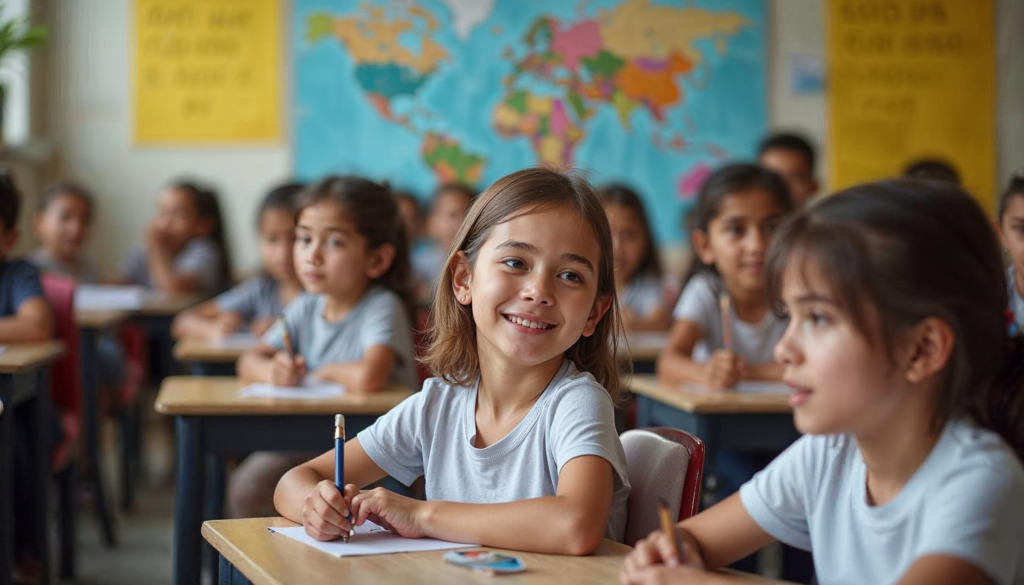In the increasingly diverse landscape of U.S. schools, Social-Emotional Learning (SEL) has emerged as a cornerstone for fostering student well-being and academic achievement. Latin American teachers play a unique and indispensable role in advancing SEL, offering insights, approaches, and empathy deeply rooted in their cultural and personal experiences.
Beyond the shared skills of their peers, Latin American teachers bring an intrinsic understanding of migration, resilience, and community-building—qualities that resonate profoundly with students navigating similar challenges. Studies, such as those by the Learning Policy Institute, indicate that culturally responsive teaching significantly enhances students’ emotional regulation and academic performance, further underscoring the invaluable contributions of these educators.
Building Relationships Through Cultural Understanding
At the heart of SEL lies the ability to cultivate meaningful relationships, and Latin American teachers excel in this area due to their profound cultural understanding. While customs, language, and traditions form a strong foundation, these teachers bring additional layers of connection. Many have firsthand experience of migration or navigating bicultural identities, which allows them to empathize deeply with students facing similar transitions. This lived experience provides a wellspring of understanding that goes beyond surface-level cultural knowledge.
For example, Latin American teachers often understand the unspoken cultural norms that influence students’ behavior, such as indirect communication styles or the importance of familial hierarchy. Recognizing these dynamics, they can tailor their interactions to establish trust and respect. Furthermore, research shows that students who feel understood by their teachers are more likely to engage in learning and demonstrate resilience. These relationships not only boost emotional well-being but also foster academic persistence and improved classroom performance.
Cultural Background and the Identification of Social-Emotional Needs
For instance, research from the American Educational Research Association emphasizes that students from immigrant families often face unique challenges, such as acculturative stress or feelings of isolation. A Latin American teacher, attuned to these realities, might notice signs of withdrawal or anxiety and proactively intervene. By introducing culturally familiar practices—like group discussions framed around shared storytelling or peer mentoring—they provide targeted support that fosters emotional stability and academic focus. These proactive approaches directly enhance students’ ability to engage and succeed academically.
Culturally Responsive Teaching as a Catalyst for SEL
Culturally responsive teaching is a hallmark of effective SEL, and Latin American teachers exemplify this practice by integrating students’ cultural contexts into every aspect of their instruction. They use teaching methods that honor students’ backgrounds while equipping them with the social-emotional tools needed to thrive in diverse environments.
For example, a teacher might incorporate “talleres,” a Latin American instructional approach that mirrors project-based learning but emphasizes hands-on collaboration rooted in community values. This method allows students to explore and apply their knowledge while fostering teamwork and shared accountability. CASEL research highlights that such culturally grounded practices enhance student self-regulation and problem-solving skills, key components of both SEL and academic success.
Additionally, Latin American teachers often adapt classroom discussions to include cultural references that resonate with their students. For instance, a teacher might explore themes of resilience through the stories of Latin American historical figures, helping students process emotions while connecting to their heritage. These strategies not only deepen emotional intelligence but also cultivate a sense of pride and belonging, which are critical for sustained academic engagement.
The Broader Impact on School Communities
The influence of Latin American teachers extends beyond the classroom, enriching the entire school community. Their ability to bridge cultural gaps fosters stronger partnerships between schools and families, an essential component of effective SEL. By engaging parents through culturally sensitive communication and inclusive events, these teachers create a supportive network that reinforces students’ social-emotional development at home and at school.
For example, schools with active involvement from culturally responsive educators have been shown to experience improved parental participation rates, according to a study by Harvard’s Graduate School of Education. Latin American teachers often play pivotal roles in organizing events that celebrate cultural diversity, which strengthens the home-school connection and amplifies the SEL benefits for students. These inclusive efforts build a cohesive community that supports students holistically.
Furthermore, Latin American teachers often advocate for systemic changes that prioritize SEL, such as implementing culturally inclusive curricula or promoting professional development focused on equity and empathy. Their leadership in these areas not only enhances the immediate educational environment but also contributes to a broader shift toward more inclusive and supportive school cultures.
A Foundation for Lifelong Success
Social-emotional learning is a critical predictor of lifelong success, and the unique contributions of Latin American teachers play a pivotal role in shaping this foundation. Through their cultural understanding, responsive teaching, and unwavering commitment to student well-being, these educators ensure that every child is equipped to navigate the complexities of both their academic journey and their personal lives.
By combining their cultural fluency with innovative teaching practices and a deep commitment to equity, Latin American teachers transform schools into dynamic learning environments. Their ability to bridge the gap between diverse cultural backgrounds and the demands of the U.S. education system creates a powerful synergy that enhances both student well-being and academic outcomes. As research increasingly demonstrates the profound link between SEL and student success, the presence of Latin American teachers becomes not just an asset but a necessity, ensuring that every student has the support and inspiration to thrive in an interconnected world.
This blog was written by Global Workforce Development, powered by IAG, an organization dedicated to creating international job opportunities for professionals.

